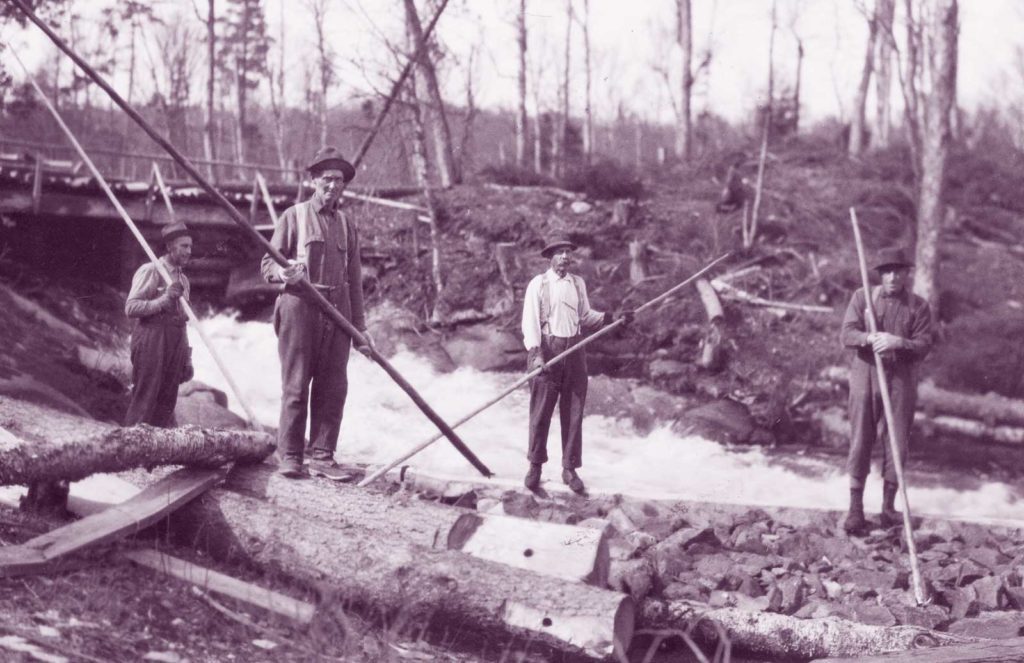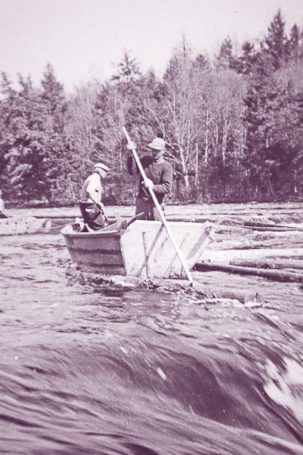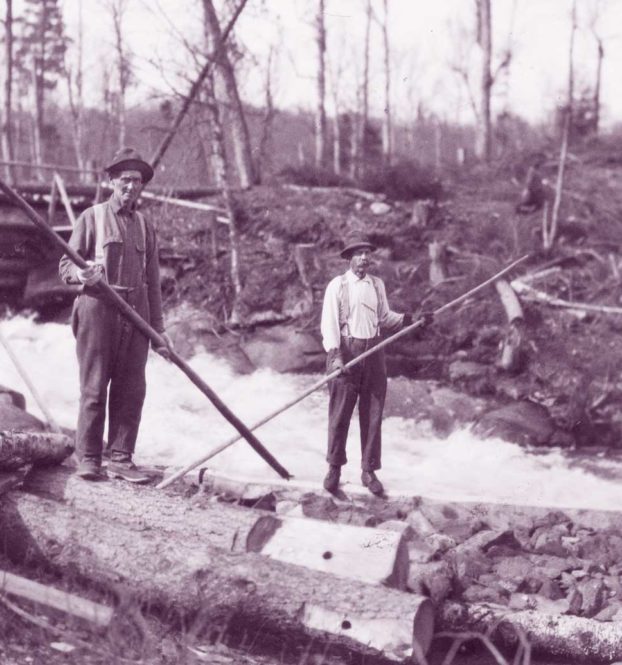The “warp and woof” of old-time river drives has long since ended. A logger named John Shields remembered his river driving career in a 1916 interview when he recalled the “good old days.” His memories of those times and those river drives invoked the romance of past logging days. Shields said, “It was always a grand sight to see those big pine logs, with the bright sunshine on them, floating downstream.”

A Look Back In Time
The “warp and woof” of log drives
An article printed in “The Northern Logger “, Jan. 2022
The “warp and woof” of old-time river drives has long since ended. A logger named John Shields remembered his river driving career in a 1916 interview when he recalled the “good old days.” His memories of those times and those river drives invoked the romance of past logging days. Shields said, “It was always a grand sight to see those big pine logs, with the bright sunshine on them, floating downstream.”
Shields once drove logs down rivers and creeks in western New York, but his experiences mirror those of other river drivers throughout the state and nation. Older river drivers were fond of recalling their former big river log drives. Often the work was a family affair. Shields’s brother was also employed in the logging industry. Said Shields, “My brother Jim first worked with the crew; then Jim went ahead as boss over some men who broke the log jams. I stayed behind with a crew whose duty it was to see that all stray logs that had lodged on the banks were rolled into the stream and restarted on their way down the creek. Sometimes the logs were backed up so far that a team [of horses] would have to haul them back to the bank.”
At one time, river driving was the easiest and quickest means of transporting logs. This did not mean by barge, boat or log rafts, but by actually floating single logs with the current downstream from forest to mill. Log drives were exciting and dangerous aspects of logging. They were the last of what was once a common logging practice dating back to Colonial days.
The log drive was a regular feature for several generations, and there are many photographs of log drives after the advent of modern photography, both still and motion. Some of the latter days of the event were captured by a few novices, such as the Rev. Frank A. Reed, who used a 16-mm movie camera. Log drives were marked by accidents as well as successes, and were among the most picturesque events in logging history.
For several generations now, people have known about log drives and log jams only as legend. And although we rush to absorb the latest technological advances, our lives are less rich in that we will never witness first-hand one of the great dramas Log drivers of American industry. Log drives demanded crews of great skill, courage and daring as well as men who were nimble and quick of foot. And as great flows of logs sped down the rivers, the spectacle attracted crowds of curious spectators who cheered with hurrahs and hoots.
Kay Halloran and Eileen MacKinnon told me similar stories in 2005 of their father’s work as a log driver. Their father was Alexander “Sandy” Currie. Halloran said, “He left home at 14 to work on the log drives and did it for 15 years.” Currie’s log driving work came to an end after he met his wife in a boarding house following a river drive. After they married, his wife insisted he end participating on the log drives. The sisters believed their father had “a rugged life in his youth.” MacKinnon painted a picture of their father as a man with huge hands, “probably from working on the river.”
Halloran said that because of Currie’s expertise in working with dynamite, a skill he learned while on the log drives, he was called on “all throughout New England, from Maine and into New York State, wherever coffer dams were being built for paper mills.” He helped build bridges and abutments and helped direct sand bagging during the flood of 1936, when he was a foreman in the Civilian Conservation Corps during the Great Depression.

All winter, lumberjacks felled trees and stacked the logs in high stacks called “decks” sometimes 20 to 50 feet high on frozen rivers and on the edges of streams. When the river hit just the right stage – high and still rising slightly in the spring, the decks were dumped into the rushing water. Luck was never really with the drivers. The downriver journey of logs was never without incident. Perhaps a river dropped too sharply, and giant log jams formed on river islands, along the shore and against bridge pilings. There were pitches, rips and falls – all of which added to the ever-present danger of keeping the “sticks” moving down the rushing and sometimes angry water. Dynamite was often the loggers’ only weapon in breaking a log jam. Some men worked from bateaus to pull logs from eddies. Others used peaveys and pike poles, working from floating logs and boats that went up and down the river.
In the early days, a majority of logs went to sawmills along rivers. Later on, major log drives throughout the Northeastern states provided the wood used in making pulp for paper. And in time the indispensable tools – long pike poles, peaveys or cantdogs, and river driving boats that shepherded logs downstream – were replaced by the chainsaw, the truck and the log chain. In turn, river drivers became truck drivers. Automation and mechanization have now taken over every segment of American life. The warp and woof of early log drives is now only a romantic memory of old-time logging days. Log driving was a victim of mechanization, truck and rail transportation – all of which could do the job more economically.

Log drivers Willie Snyder and Charles Auston knew they needed to ride logs and handle pike poles and peaveys skillfully – or quit. There was no in between. White water men couldn’t wise crack themselves out of a jam and no alibi would save their life if they had to “ride her.”
PHOTOS COURTESY LYONS FALLS HISTORY ASSOCIATION